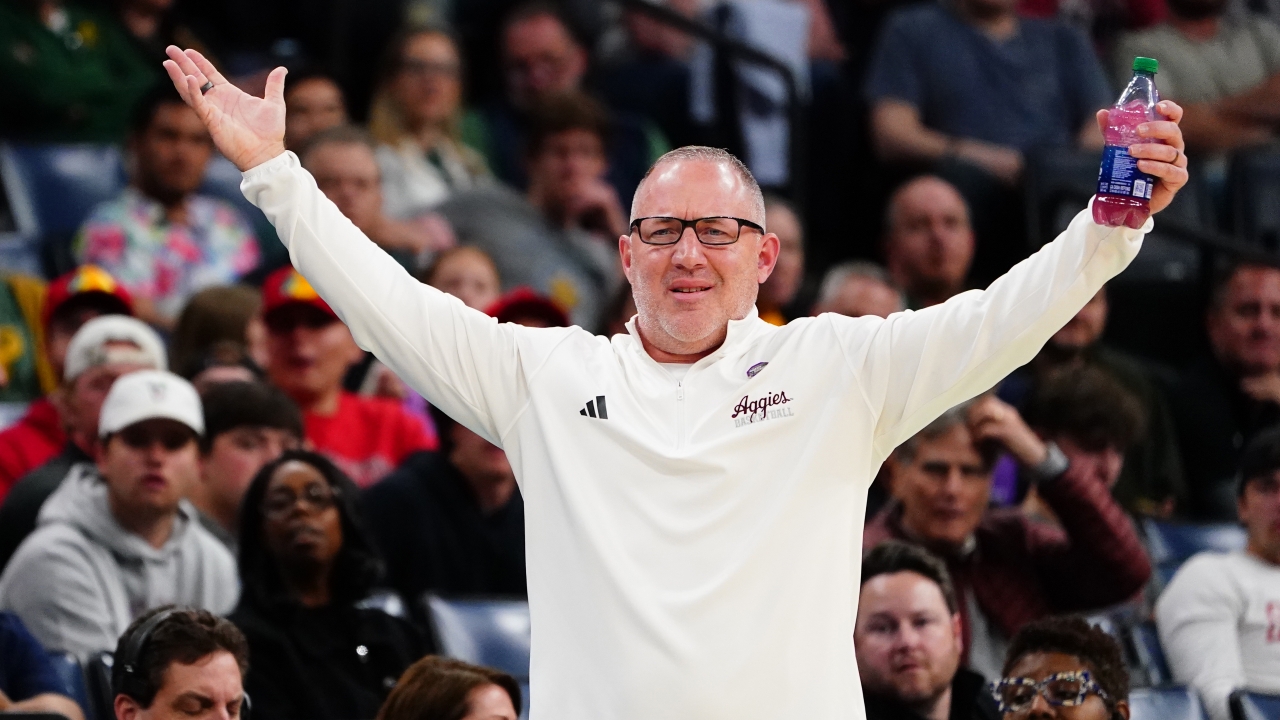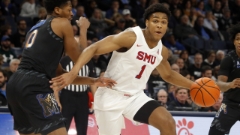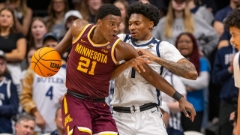

Under-the-radar storylines for Aggie hoops heading into 2024-25
The 2024-25 season for Texas A&M basketball is less than a month away, and expectations have never been higher for Buzz Williams and his squad.
The program is fresh off back-to-back NCAA Tournament appearances, three straight deep runs in the SEC Tournament, and returns the most production in the SEC by a wide margin, so it’s easy to see why the stakes are so high for this upcoming season.
Texas A&M is poised to make a statement and finally break through to the second weekend in March Madness. They have the pieces to do it, the hype to match it and a preseason top-25 ranking by their name.
But only time will tell the fate of Williams’ most talented team yet in Aggieland.
The Aggies are living above the radar as a team to beat in the SEC. Let’s look at some of the storylines heading into this season that are under the radar.
Under-the-radar non-conference game: Season opener at UCF on Nov. 4
Since their 2022 March Madness snub, Williams has made it a point to stack his non-conference schedule to gain a favorable advantage in the NET rankings by playing the most Quad 1 games possible.
With one of the toughest non-conference schedules in the country that includes trips to national runner-up Purdue and Texas Tech, home games against Ohio State and Wake Forest and a loaded Players Era Festival lineup in Las Vegas that includes three tournament locks in Creighton, Oregon and San Diego State, the Aggies have their work cut out for them in November and December.
With all of these high-profile matchups, the season opener against UCF has flown way under the radar.
Head coach Johnny Dawkins has transformed Central Florida into an up-and-coming threat in the Big 12. Last season the Knights knocked off three ranked opponents. In their inaugural Big 12 game, the Knights erased a 16-point deficit against No. 3 Kansas to stun the Jayhawks and also took down No. 23 Oklahoma and No. 23 Texas Tech during their conference slate.
UCF won seven conference games in the deepest league in the country last year while having to replace the production of one-and-done lottery pick Taylor Hendricks, who was drafted ninth overall to the Utah Jazz in the 2023 NBA draft.
Dawkins has recruited exceptionally well recently, bringing in two of the most popular high school recruits of this modern recruiting era — Mikey Williams and Dior Johnson — and added some serious length in 7-foot-2 center Moustapha Thiam from Senegal.
Dawkins has also bolstered this roster through the transfer portal with the additions of 6-foot-10 forward Rokas Jocius from Lipscomb and 6-foot-3 guard Jordan Ivy-Curry, who averaged 18.1 points per game for UTSA to finish as the fifth leading scorer in the American Athletic Conference.
The Knights return a trio of starting guards with Keyshawn Hall, who averaged 16.6 points and 8.1 rebounds per game, Jaylin Sellers, who averaged 15.9 points per game, and Darius Johnson, who averaged 15.2 points per game. Between Ivy-Curry, Hall, Sellers, and Johnson, UCF has one of the more underrated and experienced guard quartets in the country, which will provide an incredible matchup for Wade Taylor IV, Manny Obaseki, Zurich Phelps, CJ Wilcher and Jace Carter.
The Maroon & White will only go as far as their guard play will take them this season, and when the Knights and Aggies meet in Orlando to kick off the 2023-24 season, we’ll get to see an underrated matchup between two of the best backcourt units in the country. This is a game that not enough people are talking about nationally and within the Aggie community for the test it will bring right out of the gate.
Grab your popcorn because Disney World won’t be the only place in Orlando with fireworks on Nov. 4th.
Under-the-radar conference game: South Carolina, Feb. 1
The Aggies will face perennial SEC contenders Alabama, Tennessee, Kentucky, Arkansas and newcomer Texas for six of their 18 conference games this season. Those high-profile matchups will be must-wins for A&M’s postseason resume. Winning half of those six heavyweight matchups would be the difference between Williams’ team earning a top-four seed in the NCAA Tournament or struggling to separate their resume from other teams on the seven, eight, and nine seed line. In a league as talented as the SEC, it’s difficult to pick a game that is truly flying under the radar. A&M knows better than most that you cannot underestimate any opponent, but this specific game could be significantly more important than the experts are making it out to be.
It’s important to add context to see why this South Carolina game is so important. The middle of A&M’s schedule features a stretch of games where the Aggies host LSU, travel to Ole Miss, travel to Texas, host Oklahoma, travel to South Carolina, travel to Missouri and host Georgia.
The Texas game in Austin will be the only game in that stretch where the Aggies will be underdogs, making this a favorable stretch of winnable games. Historically, Williams’ teams start to lose steam in the middle of SEC play before locking in down the stretch. Positioned right in the middle of the schedule, this tilt in Columbia will set the tone for the back half of the SEC schedule. This is a revenge game for last season when Lamont Paris and his Gamecocks came to Reed Arena and won at the last second with A&M’s tournament hopes flatlining.

Chattanooga.
Paris, the 2024 SEC Coach of the Year, rebuilt this program in one season and is poised for another top-five finish in the SEC as he brings in a loaded transfer portal class that includes Nick Pringle from Alabama, MEAC player of the year Jamarii Thomas from Norfolk State and Jordan Butler from Missouri. Win this game and the Aggies will likely take a three-game winning streak full of momentum into a packed house at Reed Arena for a showdown with Arkansas.
For its implications on the schedule and for how underrated South Carolina will be for a second straight season, I believe this matchup is flying under the radar as one of the most important conference games in this upcoming schedule.
Under-the-radar statistical improvement: Turnovers
In the 2023-24 season, the Aggies were boom or bust across most statistics. Leading the country in offensive rebounding, defensive rebounding and turnovers forced were key to A&M’s success last season, but some areas of concern ultimately doomed them in March Madness. The glaringly obvious answer when you look for a statistical improvement this season is 3-point shooting and free-throw shooting.
Improve those stats by a couple of percentage points, and the Aggies would’ve had a better resume and likely made a deeper run in March Madness.
Those areas for improvement are well-documented and Williams has made it a point to address those needs in both the portal and what he’s emphasizing in practice. A statistic that could improve in the 2024-25 season that is flying under the radar is how much better the Aggies should be at holding onto the ball and improving both their turnover margin and assist-to-turnover ratio.
The Aggies have to be better with ball security. Last season they averaged 14.8 turnovers per game, tied for the highest under Williams. They also had a +0.4 turnover margin, which was tied for the lowest under Williams, and an 0.8 assist-to-turnover ratio, which was tied for the lowest under him.
Turnover numbers at Texas A&M under Buzz Williams
| Stat | 2019-20 | 2020-21 | 2021-22 | 2022-23 | 2023-24 |
| Turnovers per game | 14.1 | 14.8 | 13.8 | 12.3 | 14.8 |
| Turnover margin | +0.7 | +0.4 | +3.8 | +1.7 | +0.4 |
| Assist to turnover ratio | 0.8 | 0.8 | 1.0 | 1.0 | 0.8 |
Reducing turnovers all starts up top with your main ball handlers in Taylor, Obaseki and Phelps. These three primary guards now have a combined nine years of college basketball experience under their belt. More experienced players make fewer mistakes, and the chemistry built from Taylor and Obaseki playing together for a fourth season and Taylor and Phelps growing up playing AAU ball together will go a long way this season towards taking pressure off this trio of veteran decision-makers.
Taylor’s average number of turnovers increased from 1.8 to 2.6 to 2.8 per game throughout his college career, coincidentally when he took on more responsibility in the offense with the departure of Quenton Jackson and Dexter Dennis. Obaseki taking a more aggressive role in this offense down the stretch jump-started this offense, took the pressure off Taylor, and was one of the main reasons why A&M was able to make a late-season push off the bubble and into the NCAA Tournament.

If Obaseki plays at that level and Phelps builds on his crafty skillset from SMU, you could be looking at one of the best backcourts in the country residing in College Station. Obaski’s turnovers per game decreased from 1.3 to 0.9 from his sophomore season to his junior season last year. Phelps’s turnovers per game decreased from 2.7 to 2.1 from his sophomore season to his junior season last year. Both of these guards proved they could clean up their turnovers even with the ball in their hands more in their respective offenses last season, and I expect those trends to continue for Obaseki and Phelps this season.
The three transfer portal additions of Payne, Phelps and Wilcher will provide a plethora of scoring options for A&M’s offense to boost assist numbers and subsequently improve the assist-to-turnover ratio. The transfer trio averaged a combined 32.5 points, 11.7 rebounds, 4.7 assists, and 2.7 steals per game last season.
Statistically, they’ll be able to more than replace the 18.1 points, 9.0 rebounds, 2.7 assists and 0.6 steals per game lost by the departures of Tyrece Radford and Wildens Leveque.
With A&M returning 82.5 percent of their production from a season ago and adding three key pieces in the portal, there is a clear focus on offensive firepower, but I believe one of the more underrated statistical improvements will be how the oldest team in the SEC can reduce their turnover numbers and boost both their turnover margin and assist-to-turnover ratio.
Under-the-radar player: Pharrel Payne, 6-foot-9 junior forward
I’m not sure how it’s possible for a 6-foot-9 human being to ever be under the radar, but I can promise you he is. Payne, a junior forward who transferred this offseason from Minnesota, is the basketball equivalent of Mike Elko adding Ar’maj Reed-Adams through the transfer portal.
At first glance, most A&M fans said “Oh great, we got an offensive lineman from Kansas.”
Reed-Adams flew under the radar for most of the offseason and quietly added a much-needed veteran, gritty and mauling presence to one of the weaker units on Texas A&M’s team last season.
Now, six weeks into the season, it is clear that Reed-Adams sets the tone physically for this offensive line and was one of the most valuable offseason additions. I see Payne having a similar impact on the Aggie frontcourt.
Over the last few seasons, the frontcourt has left a ton of meat on the bone for Williams’ squad. Taylor, Dennis, Jackson and Radford have provided stability and production in the backcourt, but the same cannot be said about a consistent producer in the frontcourt. Nobody questions the rebounding prowess of Andersson Garcia, Solomon Washington and Henry Coleman III, but aside from a few scoring spurts, none of these talented pieces have posed a consistent scoring threat to opposing defenses.

Payne averaged 10 points and 6.1 rebounds per game on a Minnesota squad that earned an NIT bid out of the Big Ten. He played 62 of a possible 65 games for the Gophers during his freshman and sophomore seasons and averaged 23 minutes per game. In his 32 games as a sophomore, Payne started 19 and scored at least eight points in 22 games. For comparison, last season Coleman eclipsed eight points 17 times, Garcia hit that milestone 13 times and Washington did that just 11 times.
The most exciting aspect about Payne isn’t just the numbers, it’s how and where he scores. He’s a true lob threat, will post up with his back to the basket and can run in transition to create havoc after A&M grabs a rebound. Defenses will need to keep their head on a swivel with Payne lurking in the paint. Allow your mind to imagine for a second how much more dangerous Taylor would be when you add this weapon to the pick-and-roll game. Defenses won’t be able to key in on Taylor’s floater in the lane with the threat of Payne catching a lob and slamming it home.
This element has been missing from A&M’s offense since Julius Marble in the 2022-23 season, but Payne has already proven to be more effective in this area.
Payne’s scoring presence will open things up for everyone on the court and with the existing frontcourt pieces gaining another valuable year of postseason experience, you have to love the direction this unit is heading as we approach a crucial 2024-25 season in College Station.
Defensively, Payne is a force to be reckoned with, boasting a 6.2 percent block rate in 11 games last season with multiple blocks.
In past transfer portal classes, Williams’ most successful frontcourt additions have been unproven younger players who didn’t contribute at their past schools and had a chance to grow at Texas A&M.
Garcia averaged three minutes and two points per game at Mississippi State. Now, he’s one of the best rebounders in the country.
Coleman averaged five minutes and one point per game at Duke. Now, he’s a veteran leader on a squad poised to make a deep run into March Madness.
Despite being a junior, Payne is one of the younger players on his team, but you would be a fool to also categorize him as unproven. The big man was thrown into the fire at Minnesota and missed just three games over two years while averaging 9.1 points and 5.7 rebounds per game over his career.
I expect him to play a major role on this roster and shore up the frontcourt with Garcia, Washington and Coleman, making these four one of the most experienced, versatile and rebound-hungry frontcourts in the country.

